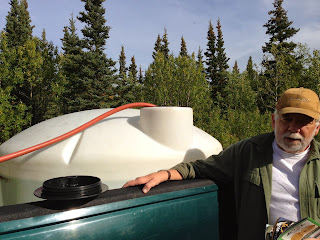Rural Alaska: Hauling Drinking Water From A Local Pump House – From Bearfoot Travel Magazines
Copper River Country Journal
at
04:05
 |
| Hauling water in a truck in Healy, Alaska. |
For A Place With So Many Rivers, Getting Drinking Water In Alaska Is Not Easy
Water hauling is a huge
problem in rural Alaska. It doesn't matter where you live; many people
don't have running water. This is true even in the city of Fairbanks,
where "dry" (i.e. waterless) cabins are rented out to college students
who are going to school at the nearby University of Alaska.
 |
| McCarthy, Alaska "community drinking water" sign. |
In many parts of the state
along the road system, entrepreneurs set up small pump houses over their
wells, and charge by the gallon, with coin-operated timers. The
simplest system is to load 5-gallon jugs. This large plastic container
is especially designed for hauling water. It fits into the back of a
pickup, and is made so the water won't splash out when it's transported
back home. On arriving home, the water is pumped back out of the
container and into another container, inside the warm house.
 |
| "Coin-op" water pump in Gakona, Alaska. |
Hauling water is an arduous task, often done in the middle of the night, at temperatures that can go down to 50 below zero.
 |
| Pump house in Eagle, Alaska. |
 |
| Water is precious in Alaska. |
 |
| Winter water hauling in Kenny Lake, Alaska. (Photo: Neil Hannan) |
 |
| Water sign at Clear, Alaska lodge. |
Alaska Survival
















































I didn't realize that it was so difficult to get drinking water in Alaska. I can't imagine what it must be like to not have running water. Hauling water in such cold weather can't be easy.
ReplyDeleteSusan Hirst | http://www.dwjensendrilling.com/
Hi Susan, Yes, it's very hard. During the days before well drilling (and I see you're a drilling company) people had to drink water from streams. You might think: "Well, the streams are clean and not polluted." Some are, of course. But I live near the Copper River. It's a glacial river, and to drink from it, you have to pour water into a bucket, let the silt drop to the bottom, then pour the clean water into another bucket, and let that silt drop, and so on, so you're not drinking sand! This is what Native Americans did in the past, probably in birch or their own copper containers from local copper. We have taken photos of water stations like the one in this blog in the following locations: Kenny Lake, Tazlina, Eagle, Healy, Clear, and even in Fairbanks, where many university students rent cheaper "dry" cabins -- meaning cabins with no water.
ReplyDelete